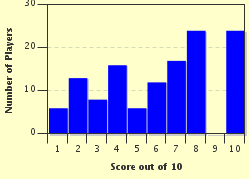Quiz Answer Key and Fun Facts
1. Music proved to be the undoing of this 100-eyed giant.
2. Like a laser beam, this deity's third eye incinerated the god of love.
3. A single glance from this creature had the power to kill any living being.
4. This Egyptian deity's eye was considered a powerful symbol of protection.
5. This Asian goddess of mercy is often depicted with one thousand arms and eyes.
6. He traded one of his eyes for a drink of water from the well of knowledge.
7. These one-eyed giants forged Zeus' lighting bolts and other divine weapons.
8. He was given the gift of prophecy in compensation for losing his sight.
9. With his thousand eyes, this ancient Hindu god saw all that happened in the world.
10. These three sisters, whose Greek name means "the grey ones", shared one eye and one tooth among them.
Source: Author
LadyNym
This quiz was reviewed by FunTrivia editor
agony before going online.
Any errors found in FunTrivia content are routinely corrected through our feedback system.


